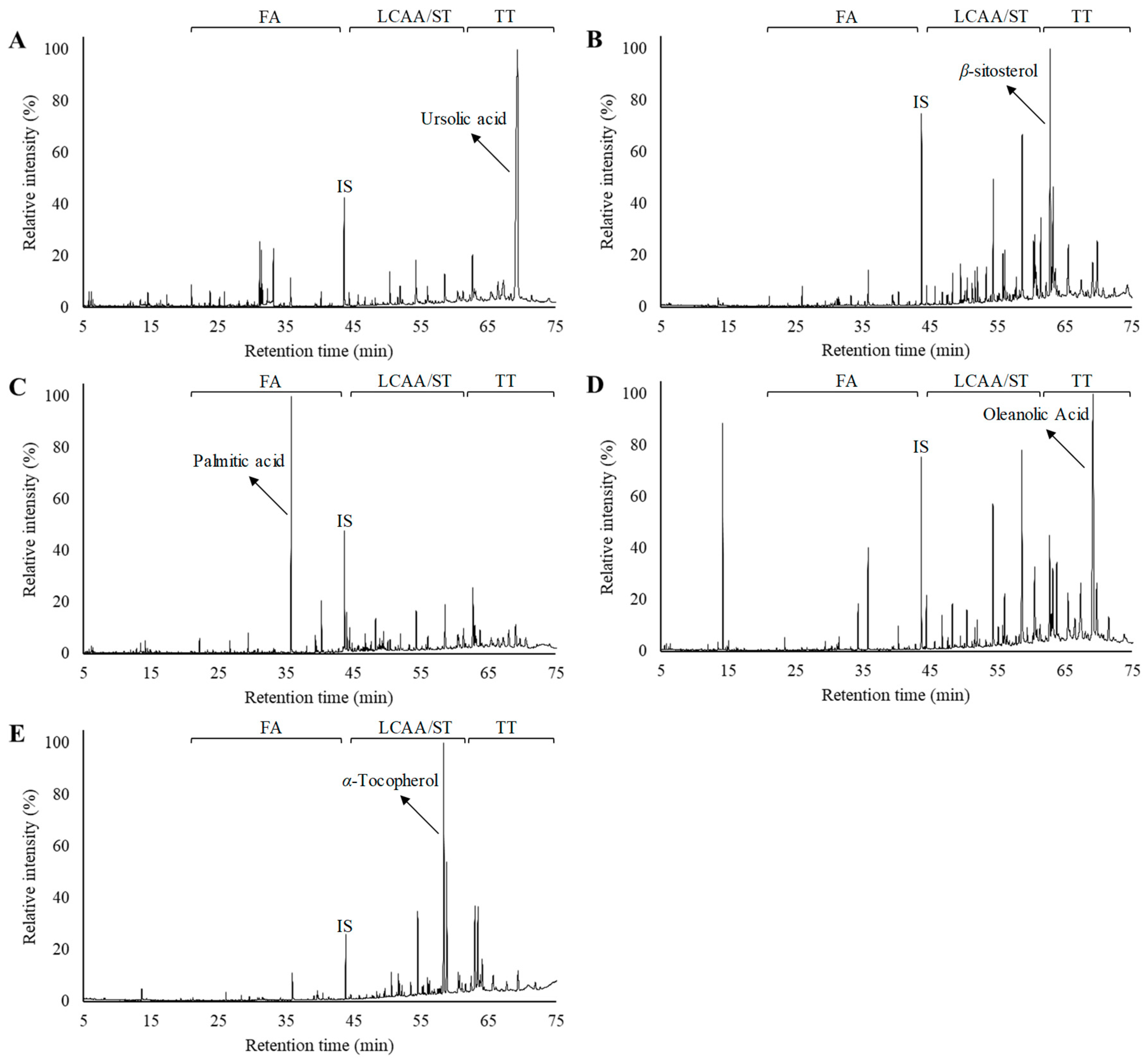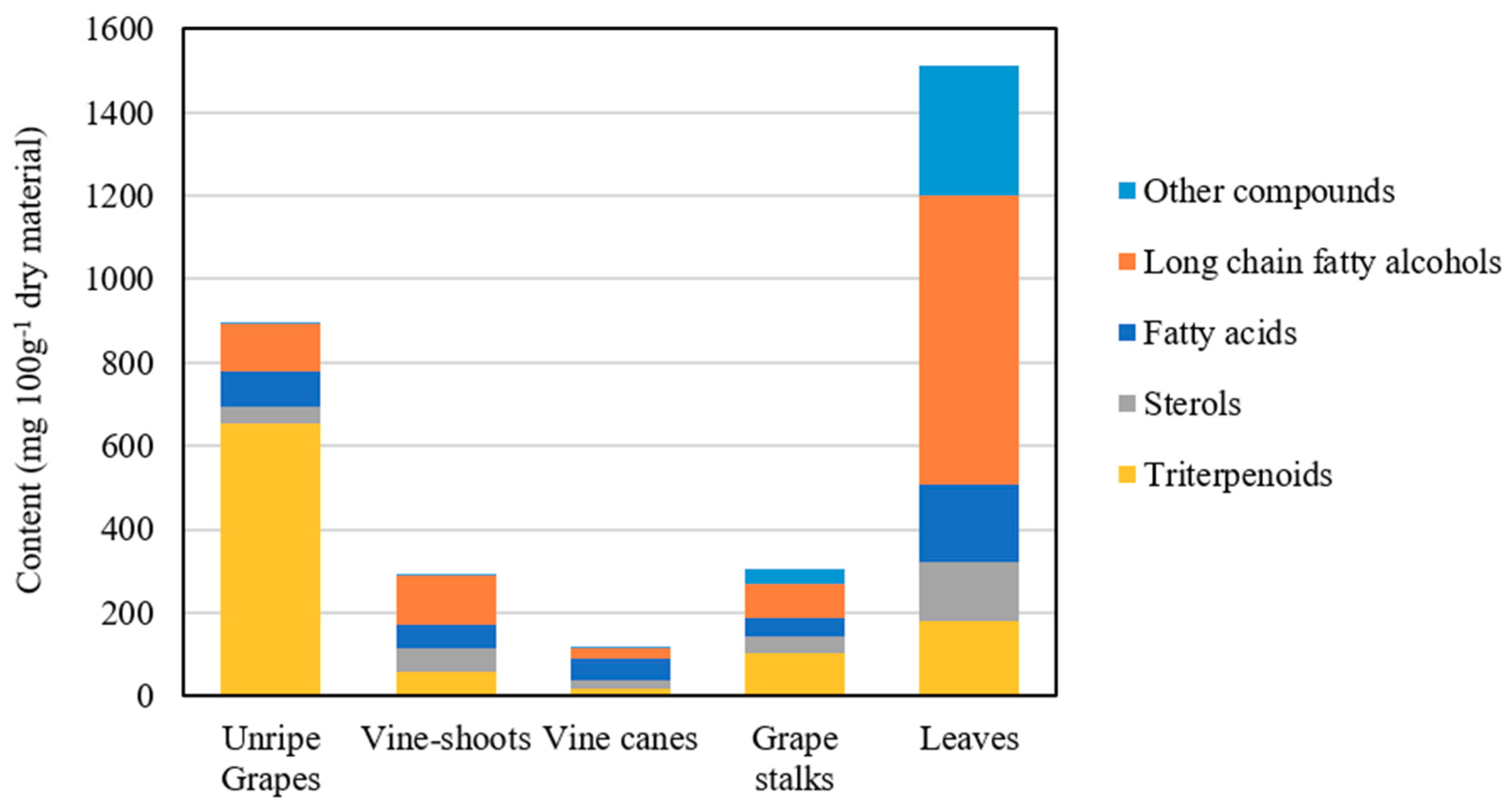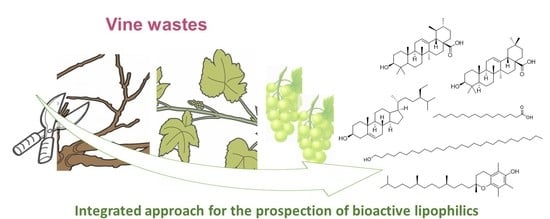Vine Waste Valorisation: Integrated Approach for the Prospection of Bioactive Lipophilic Phytochemicals
Abstract
:1. Introduction
2. Results and Discussions
2.1. Chemical Composition of Vine Waste Lipophilic Extracts
2.2. Fatty Acids
2.3. Long-Chain Aliphatic Alcohols
2.4. Sterols
2.5. Triterpenic Components
2.6. Other Components
3. Materials and Methods
3.1. Sampling and Handling
3.2. Characterization of the Lipophilic Compounds
4. Conclusions
Author Contributions
Funding
Conflicts of Interest
Abbreviations
| GC–MS | Gas Chromatography–Mass Spectrometry |
| DCM | Dichloromethane |
| dw | Dry weight |
| RSD | Relative standard deviation |
| PUFA | Polyunsaturated fatty acids |
| LD | Linear dichroism |
| LDL | Low-density lipoprotein |
| EFSA | European Food Safety Authority |
References
- Deiana, A.C.; Sardella, M.F.; Silva, H.; Amaya, A.; Tancredi, N. Use of grape stalk, a waste of the viticulture industry, to obtain activated carbon. J. Hazard. Mater. 2009, 172, 13–19. [Google Scholar] [CrossRef]
- Sánchez-Gómez, R.; Sánchez-Vioque, R.; Santana-Méridas, O.; Martín-Bejerano, M.; Alonso, G.L.; Salinas, M.R.; Zalacain, A. A potential use of vine-shoot wastes: The antioxidant, antifeedant and phytotoxic activities of their aqueous extracts. Ind. Crops Prod. 2017, 97, 120–127. [Google Scholar] [CrossRef]
- FAOSTAT Food and Agriculture - Organization of the United Nations Food and Agriculture Data. Available online: http://www.fao.org/faostat/en/#data/QC (accessed on 28 August 2019).
- Zhu, F.; Du, B.; Zheng, L.; Li, J. Advance on the bioactivity and potential applications of dietary fibre from grape pomace. Food Chem. 2015, 186, 207–212. [Google Scholar] [CrossRef] [PubMed]
- Beres, C.; Costa, G.N.S.; Cabezudo, I.; da Silva-James, N.K.; Teles, A.S.C.; Cruz, A.P.G.; Mellinger-Silva, C.; Tonon, R.V.; Cabral, L.M.C.; Freitas, S.P. Towards integral utilization of grape pomace from winemaking process: A review. Waste Manag. 2017, 68, 581–594. [Google Scholar] [CrossRef] [PubMed]
- Daane, K.M.; Vincent, C.; Isaacs, R.; Ioriatti, C. Entomological Opportunities and Challenges for Sustainable Viticulture in a Global Market. Annu. Rev. Entomol. 2016, 193–214. [Google Scholar] [CrossRef] [PubMed]
- Zacharof, M.P. Grape winery waste as feedstock for bioconversions: applying the biorefinery concept. Waste Biomass Valorization 2017, 8, 1011–1025. [Google Scholar] [CrossRef]
- Teixeira, A.; Baenas, N.; Dominguez-perles, R.; Barros, A.; Rosa, E. Natural bioactive compounds from winery by-products as health promoters: A Review. Int. J. Mol. Sci. 2014, 15, 15638–15678. [Google Scholar] [CrossRef]
- Santana-Méridas, O.; González-Coloma, A.; Sánchez-Vioque, R. Agricultural residues as a source of bioactive natural products. Phytochem. Rev. 2012, 11, 447–466. [Google Scholar] [CrossRef]
- Pensec, F.; Pączkowski, C.; Grabarczyk, M.; Woźniak, A.; Bénard-Gellon, M.; Bertsch, C.; Chong, J.; Szakiel, A. Changes in the triterpenoid content of cuticular waxes during fruit ripening of eight grape (Vitis vinifera) Cultivars Grown in the Upper Rhine Valley. J. Agric. Food Chem. 2014, 62, 7998–8007. [Google Scholar] [CrossRef]
- Pujol, D.; Liu, C.; Fiol, N.; Olivella, M.À.; Gominho, J.; Villaescusa, I.; Pereira, H. Chemical characterization of different granulometric fractions of grape stalks waste. Ind. Crops Prod. 2013, 50, 494–500. [Google Scholar] [CrossRef]
- Ping, L.; Brosse, N.; Sannigrahi, P.; Ragauskas, A. Evaluation of grape stalks as a bioresource. Ind. Crops Prod. 2011, 33, 200–204. [Google Scholar] [CrossRef]
- Prozil, S.O.; Evtuguin, D.V.; Lopes, L.P.C. Chemical composition of grape stalks of Vitis vinifera L. from red grape pomaces. Ind. Crops Prod. 2012, 35, 178–184. [Google Scholar] [CrossRef]
- Ramos, R.A.; Guerra, A.R.; Guerreiro, O.; Freire, C.S.R.; Silva, A.M.S.; Duarte, M.F.; Silvestre, A.J.D. Lipophilic extracts of Cynara cardunculus L. var. altilis (DC): A source of valuable bioactive terpenic compounds. J. Agric. Food Chem. 2013, 61, 8420–8429. [Google Scholar] [CrossRef] [PubMed]
- Alvarruiz, A.; Pardo, J.E.; Fernández, E.; Rubio, M.; Alvarruiz, A.; Alonso, G.L. Characterization of grape seed oil from different grape varieties (Vitis Vinifera). Eur. J. Lipid Sci. Technol. 2016, 111, 188–193. [Google Scholar] [CrossRef]
- Fernandes, L.; Casal, S.; Cruz, R.; Alberto, J.; Ramalhosa, E. Seed oils of ten traditional Portuguese grape varieties with interesting chemical and antioxidant properties. Food Res. Int. J. 2013, 50, 161–166. [Google Scholar] [CrossRef]
- Hebash, K.A.H.; Fadel, H.M.; Soliman, M.M. Volatile components of grape leaves. J. Islamic Acad. Sci. 1991, 4, 26–28. [Google Scholar]
- Miele, A.; Bouard, J.; Bertrand, A. Fatty acids from lipid fractions of leaves and different tissues of cabernet sauvignon grapes. Am. J. Enol. Vitic. 1993, 44, 180–186. [Google Scholar]
- Pecher, V.; Andre, P. Method for preparing a lipophilic vine extract. US20100034764A1, 2015. [Google Scholar]
- Simopoulos, A.P. The importance of the Omega-6/Omega-3 fatty acid ratio in cardiovascular disease and other chronic diseases. Exp. Biol. Med. 2008, 233, 674–688. [Google Scholar] [CrossRef]
- Radler, F. The surface waxes of the sultana vine (Vitis vinifera cv. Thompson seedless). Aust. J. Biol. Sci. 1965, 18, 1045–1056. [Google Scholar] [CrossRef]
- Radler, F. The main constituents of the surface waxes of varieties and species of the genus Vitis. Am. J. Enol. Vitic. 1965, 16, 159–167. [Google Scholar]
- Radler, F.; Horn, D. The composition of grape cuticle wax. Aust. J. Chem. 1965, 18, 1059–1069. [Google Scholar] [CrossRef]
- Rubio, M.; Alvarez-Ortí, M.; Andrés, A.; Fernández, E.; Pardo, J.E. Characterization of oil obtained from grape seeds collected during berry development. J. Agric. Food Chem. 2009, 57, 2812–2815. [Google Scholar] [CrossRef] [PubMed]
- Gouni-Berthold, I.; Berthold, H.K. Policosanol: Clinical pharmacology and therapeutic significance of a new lipid-lowering agent. Am. Heart J. 2002, 143, 356–365. [Google Scholar] [CrossRef] [PubMed]
- Berger, A.; Jones, P.J.H.; Abumweis, S.S. Plant sterols: Factors affecting their efficacy and safety as functional food ingredients. Lipids Health Dis. 2004, 19, 5. [Google Scholar] [CrossRef] [PubMed]
- Ruggiero, A.; Vitalini, S.; Burlini, N.; Bernasconi, S.; Iriti, M. Phytosterols in grapes and wine, and effects of agrochemicals on their levels. Food Chem. 2013, 141, 3473–3479. [Google Scholar] [CrossRef] [PubMed]
- Batovska, D.I.; Todorova, I.T.; Nedelcheva, D.V.; Parushev, S.P.; Atanassov, A.I.; Hvarleva, T.D.; Djakova, G.J.; Bankova, V.S.; Popov, S.S. Preliminary study on biomarkers for the fungal resistance in Vitis vinifera leaves. J. Plant Physiol. 2008, 165, 791–795. [Google Scholar] [CrossRef] [PubMed]
- Løvik, M.; Marchelli, R.; Martin, A.; Moseley, B.; Van Den Berg, H.; Van Loveren, H.; Verhagen, H. Plant sterols and blood cholesterol scientific substantiation of a health claim related to plant sterols and lower/reduced blood cholesterol and reduced risk of (coronary) heart disease. EFSA J. 2008, 781, 1–12. [Google Scholar]
- Rayne, S.; Karacabey, E.; Mazza, G. Grape cane waste as a source of trans-resveratrol and trans-viniferin: High-value phytochemicals with medicinal and anti-phytopathogenic applications. Ind. Crops Prod. 2008, 27, 335–340. [Google Scholar] [CrossRef]
- Domingues, R.M.; Guerra, A.R.; Duarte, M.; Freire, C.S.; Neto, C.P.; Silva, C.M.; Silvestre, A.J. Bioactive triterpenic acids: From agroforestry biomass residues to promising therapeutic tools. Mini. Rev. Org. Chem. 2014, 11, 382–399. [Google Scholar] [CrossRef]
- Salvador, Â.C.; Król, E.; Lemos, V.C.; Santos, S.A.O.; Bento, F.P.M.S.; Costa, C.P.; Almeida, A.; Szczepankiewicz, D.; Kulczyński, B.; Krejpcio, Z.; et al. Effect of elderberry (Sambucus nigra L.) extract supplementation in STZ-induced diabetic rats fed with a high-fat diet. Int. J. Mol. Sci. 2017, 18, 13. [Google Scholar] [CrossRef]
- Tangolar, S.G.; Özogul, F.; Tangolar, S.; Yağmur, C. Tocopherol content in fifteen grape varieties obtained using a rapid HPLC method. J. Food Compos. Anal. 2011, 24, 481–486. [Google Scholar] [CrossRef]
- EFSA Scientific opinion on dietary reference values for vitamin E as α-tocopherol. EFSA J. 2015, 13, 4149. [CrossRef]
- Islam, T.; Vinícius, M.; Barros, O.; Alencar, D.; Mendes, R.; Freitas, D. Chemico-biological interactions phytol in a pharma-medico-stance. Chem. Biol. Interact. 2015, 240, 60–73. [Google Scholar] [CrossRef] [PubMed]
- Salvador, Â.C.; Rocha, S.M.; Silvestre, A.J.D. Lipophilic phytochemicals from elderberries (Sambucus nigra L.): Influence of ripening, cultivar and season. Ind. Crops Prod. 2015, 71, 15–23. [Google Scholar] [CrossRef]
- Domingues, R.M.A.; Sousa, G.D.A.; Silva, C.M.; Freire, C.S.R.; Silvestre, A.J.D.; Neto, C.P. High value triterpenic compounds from the outer barks of several Eucalyptus species cultivated in Brazil and in Portugal. Ind. Crops Prod. 2011, 33, 158–164. [Google Scholar] [CrossRef]
- Fonseca, D.F.S.; Salvador, Â.C.; Santos, S.A.O.; Vilela, C.; Freire, C.S.R.; Silvestre, A.J.D.; Rocha, S.M. Bioactive phytochemicals from wild Arbutus unedo L. Berries from different locations in portugal: Quantification of lipophilic components. Int. J. Mol. Sci. 2015, 16, 14194–14209. [Google Scholar] [CrossRef]
- Villaverde, J.J.; Vega, A.; Ligero, P.; Freire, C.S.R.; Neto, C.P.; Silvestre, A.J.D. Miscanthus x giganteus bark organosolv fractionation: fate of lipophilic components and formation of valuable phenolic by-products. J. Agric. Food Chem. 2010, 58, 8279–8285. [Google Scholar] [CrossRef]
- Sousa, A.F.; Pinto, P.C.R.O.; Silvestre, A.J.D.; Neto, C.P. Triterpenic and other lipophilic components from industrial cork by-products. J. Agric. Food Chem. 2006, 54, 6888–6893. [Google Scholar] [CrossRef]
- Freire, C.S.R.; Silvestre, A.J.D.; Neto, C.P. Identification of new hydroxy fatty acids and ferulic acid esters in the wood of Eucalyptus globulus. Holzforschung 2002, 56, 143–149. [Google Scholar] [CrossRef]
- Freire, C.S.R.; Silvestre, A.J.D.; Neto, C.P.; Cavaleiro, J.A.S. Lipophilic extractives of the inner and outer bark of Eucalyptus globulus. Holzforschung 2002, 56, 372–379. [Google Scholar] [CrossRef]
- De Melo, M.M.R.; Şen, A.; Silvestre, A.J.D.; Pereira, H.; Silva, C.M. Experimental and modeling study of supercritical CO2 extraction of Quercus cerris cork: Influence of ethanol and particle size on extraction kinetics and selectivity to friedelin. Sep. Purif. Technol. 2017, 187. [Google Scholar] [CrossRef]
- Domingues, R.M.A.; Oliveira, E.L.G.; Freire, C.S.R.; Couto, R.M.; Simoes, P.C.; Neto, C.P.; Silvestre, A.J.D.; Silva, C.M. Supercritical fluid extraction of Eucalyptus globulus bark-A promising approach for triterpenoid production. Int. J. Mol. Sci. 2012, 13, 7648–7662. [Google Scholar] [CrossRef] [PubMed]
- Domingues, R.M.A.; de Melo, M.M.R.; Neto, C.P.; Silvestre, A.J.D.; Silva, C.M. Measurement and modeling of supercritical fluid extraction curves of Eucalyptus globulus bark: Influence of the operating conditions upon yields and extract composition. J. Supercrit. Fluids 2012, 72, 176–185. [Google Scholar] [CrossRef]
- De Melo, M.M.R.; Silva, R.P.; Silvestre, A.J.D.; Silva, C.M. Valorization of water hyacinth through supercritical CO2 extraction of stigmasterol. Ind. Crops Prod. 2016, 80. [Google Scholar] [CrossRef]


| R.t. (min) | Compound | Unripe Grapes | RSD (%) | Vine-Shoots | RSD (%) | Vine Canes | RSD (%) | Grapes Stalks | RSD (%) | Leaves | RSD (%) |
|---|---|---|---|---|---|---|---|---|---|---|---|
| Fatty Acids | 84.9 | 54.9 | 55.4 | 42.5 | 182.8 | ||||||
| Saturated | |||||||||||
| 19.6 | Decanoic acid (C10:0) | n.d. | n.d. | n.d. | n.d. | 2.4 | 8.0 | ||||
| 25.6 | Dodecanoic acid (C12:0) | n.d. | 0.2 | 9.7 | 0.2 | 8.8 | n.d. | n.d. | |||
| 30.9 | Myristic acid (C14:0) | 0.8 | 18.1 | 0.6 | 5.2 | 0.4 | 9.3 | 0.2 | 26.2 | 3.6 | 9.2 |
| 35.9 | Palmitic acid (C16:0) | 15.5 | 10.7 | 6.0 | 4.3 | 34.8 | 10.7 | 9.5 | 11.2 | 45.5 | 19.9 |
| 38.2 | Heptadecanoic acid (C17:0) | n.d. | n.d. | 0.7 | 11.2 | n.d. | n.d. | ||||
| 40.4 | Stearic acid (C18:0) | 6.0 | 23.7 | 1.8 | 10.5 | 5.9 | 11.7 | 2.7 | 30.7 | 8.7 | 20.3 |
| 44.5 | Eicosanoic acid (C20:0) | 6.5 | 10.3 | 2.8 | 2.2 | 2.9 | 12.4 | 5.0 | 7.5 | 7.4 | 6.3 |
| 48.4 | Behenic acid (C22:0) | 4.3 | 28.4 | 4.1 | 2.9 | 3.9 | 9.9 | 3.9 | 15.6 | 8.9 | 9.7 |
| 52.1 | Lignoceric acid (C24:0) | 12.7 | 12.7 | 5.2 | 8.7 | 2.1 | 6.4 | 2.9 | 21.0 | 18.2 | 10.9 |
| 56.1 | Hexacosanoic acid (C26:0) | 16.0 | 25.5 | 9.4 | 20.8 | 2.1 | 5.7 | 6.8 | 10.0 | 23.1 | 4.8 |
| 65.6 | Triacontanoic acid (C30:0) | 21.0 | 20.2 | 22.7 | 2.0 | n.d. | 9.9 | 30.8 | 50.8 | 13.3 | |
| Unsaturated | |||||||||||
| 39.5 | Linoleic acid (C18:2) + linolenic acid (C18:3) | 0.6 | 30.2 | 1.3 | 27.1 | 1.7 | 13.0 | 1.0 | 19.6 | 5.6 | 31.2 |
| 39.7 | Octadec-9-enoic acid (C18:1) isomer | 1.1 | 33.5 | 0.4 | 36.0 | 0.6 | 14.0 | 0.3 | 12.3 | 6.6 | 7.3 |
| 39.8 | Octadec-9-enoic acid (C18:1) isomer | 0.5 | 0.0 | 0.5 | 29.8 | 0.2 | 8.9 | 0.3 | 8.2 | 2.0 | 17.6 |
| Long-chain fatty alcohols | 114.3 | 117.1 | 23.1 | 84.1 | 693.4 | ||||||
| 46.9 | Docosan-1-ol | 5.2 | 4.1 | 0.7 | 17.3 | 2.5 | 17.8 | 3.2 | 10.6 | 5.7 | 6.6 |
| 50.5 | Tetracosan-1-ol | 22.9 | 4.7 | 4.3 | 7.7 | 1.5 | 9.0 | 5.3 | 20.7 | 35.2 | 4.1 |
| 54.4 | Hexacosan-1-ol | 42.3 | 7.1 | 27.3 | 4.1 | 7.0 | 4.0 | 19.2 | 5.2 | 160.4 | 5.6 |
| 58.8 | Octacosan-1-ol | 32.5 | 23.2 | 48.7 | 6.1 | 9.0 | 3.2 | 38.6 | 6.0 | 292.9 | 8.8 |
| 63.3 | Triacontan-1-ol | 11.4 | 25.6 | 36.1 | 3.0 | 3.2 | 19.8 | 17.7 | 8.3 | 199.3 | 8.2 |
| Sterols | 40.0 | 57.2 | 16.9 | 40.5 | 143.6 | ||||||
| 60.8 | Campesterol | n.d. | 3.9 | 20.2 | 1.4 | 9.1 | 3.6 | 35.6 | n.d. | ||
| 61.5 | Stigmasterol | 7.0 | 13.5 | 12.4 | 17.7 | 2.9 | 3.7 | 3.5 | 27.9 | n.d. | |
| 62.9 | β-sitosterol | 21.1 | 29.1 | 35.4 | 21.5 | 7.2 | 3.1 | 13.0 | 14.1 | 143.6 | 1.7 |
| 63.2 | Stigmastanol | 11.9 | 18.9 | 5.4 | 7.1 | 5.4 | 15.4 | 20.4 | 20.5 | n.d. | |
| Triterpenic compounds | 653.5 | 58.8 | 19.4 | 103.2 | 179.5 | ||||||
| 63.7 | α-Amyrin | n.d. | 14.5 | 10.4 | n.d. | n.d. | n.d. | ||||
| 64.0 | Lupeol | n.d. | n.d. | 3.7 | 11.7 | 17.9 | 28.2 | 87.2 | 3.0 | ||
| 69.4 | Oleanolic acid | n.d. | 19.5 | 3.7 | 7.5 | 3.7 | 72.5 | 16.1 | 69.2 | 5.0 | |
| 70.6 | Ursolic acid | 653.5 | 4.0 | 24.9 | 5.2 | 4.6 | 7.7 | n.d. | n.d. | ||
| Unidentified triterpenoids | n.d. | n.d. | 3.6 | 15.5 | 12.7 | 14.9 | 23.2 | 14.9 | |||
| Other compounds | 5.6 | 1.1 | 4.2 | 34.6 | 312.7 | ||||||
| 14.3 | Glycerol | 1.4 | 21.6 | 0.4 | 6.5 | 1.1 | 15.0 | 31.7 | 24.6 | 2.3 | 9.5 |
| 29.47 | Azelaic acid | 3.5 | 16.9 | 0.7 | 4.6 | 2.3 | 16.4 | 0.7 | 10.7 | 4.7 | 14.6 |
| 39.12 | Phytol | n.d. | n.d. | n.d. | n.d. | 5.2 | 7.7 | ||||
| 47.69 | 1-monopalmitin | 0.8 | 18.8 | n.d. | 0.8 | 12.2 | 0.7 | 6.6 | n.d. | ||
| 58.19 | α-tocopherol | n.d. | n.d. | n.d. | 1.5 | 31.8 | 300.5 | 2.5 | |||
| Total content | 898.3 | 289.1 | 118.9 | 304.8 | 1512.0 |
© 2019 by the authors. Licensee MDPI, Basel, Switzerland. This article is an open access article distributed under the terms and conditions of the Creative Commons Attribution (CC BY) license (http://creativecommons.org/licenses/by/4.0/).
Share and Cite
Salvador, Â.C.; Simões, M.M.Q.; Silva, A.M.S.; Santos, S.A.O.; Rocha, S.M.; Silvestre, A.J.D. Vine Waste Valorisation: Integrated Approach for the Prospection of Bioactive Lipophilic Phytochemicals. Int. J. Mol. Sci. 2019, 20, 4239. https://doi.org/10.3390/ijms20174239
Salvador ÂC, Simões MMQ, Silva AMS, Santos SAO, Rocha SM, Silvestre AJD. Vine Waste Valorisation: Integrated Approach for the Prospection of Bioactive Lipophilic Phytochemicals. International Journal of Molecular Sciences. 2019; 20(17):4239. https://doi.org/10.3390/ijms20174239
Chicago/Turabian StyleSalvador, Ângelo C., Mário M. Q. Simões, Artur M. S. Silva, Sónia A. O. Santos, Sílvia M. Rocha, and Armando J. D. Silvestre. 2019. "Vine Waste Valorisation: Integrated Approach for the Prospection of Bioactive Lipophilic Phytochemicals" International Journal of Molecular Sciences 20, no. 17: 4239. https://doi.org/10.3390/ijms20174239
APA StyleSalvador, Â. C., Simões, M. M. Q., Silva, A. M. S., Santos, S. A. O., Rocha, S. M., & Silvestre, A. J. D. (2019). Vine Waste Valorisation: Integrated Approach for the Prospection of Bioactive Lipophilic Phytochemicals. International Journal of Molecular Sciences, 20(17), 4239. https://doi.org/10.3390/ijms20174239











